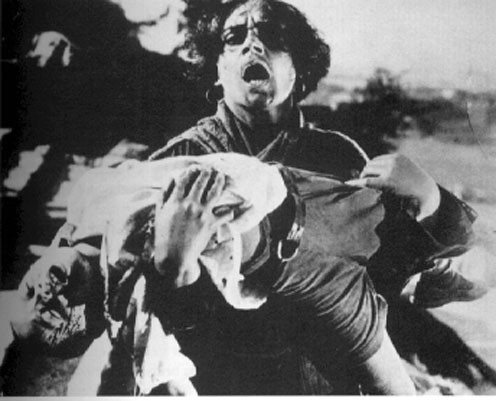
A
shot is an uninterrupted strip of exposed motion-picture film or videotape made up of at least one frame, an individual image on the strip of film or videotape. A shot presents a subject, perhaps even a blank screen, during an uninterrupted segment of time. Typically, a feature film consists of hundreds of shots, sometimes more than a thousand. The original, uncensored version of
Battleship Potemkin (1925) owned by the Museum of Modern Art in New York—which runs seventy-two minutes when projected at the silent speed of eighteen frames per second-has 1,346 shots.
Toy Story (1995), which is 77
1/2 minutes long, has 1,623 shots (Grignon). At the opposite extreme, some experimental films consist of a single, often very lengthy shot. Andy Warhol’s
Empire (1964), which is seemingly a single shot of a view of the
Empire State Building and runs for hours, is an example of this sort of film.
 Battleship Potemkin
Battleship Potemkin
A
scene is a section or a narrative film that gives the impression of continuous action taking place during continuous time and in continuous space. A scene seems to have unity, but editors often delete tedious or unnecessary footage in such a way that viewers will not notice. For example, we may not see every step a character presumably takes in moving within a scene. A scene may consist of one shot and usually consists of two or more related shots, but on rare occasions a shot is used to convey multiple scenes, as in the more than eight minute opening shot of
The Player (1992). At various times during that shot, the camera moves closer to certain groups of characters so we can see them interact and then moves to different characters elsewhere nearby. In the opening of The Player, as in the famous opening of
Touch of Evil(1958), there is not the usual scene consisting of a shot or shots but a shot consisting of scenes.
Sequence lacks a universal meaning: filmmakers, critics, and scholars often assign it different meanings. And comparison of several published outlines of sequences for the same film reveals different “sequences”. It is most useful to think of a sequence as a group of related consecutive scenes, although what unifies the scenes is not universally agreed on.
PS: You guys must be wondering why the hell I've put up celluloid in a
digital filmmaking blog! Well to put it simply - I had to. Especially when talking abut shots, scenes and sequences - the best references could have only been got from celluloid films - the traditional medium.
Digital filmmaking; being relatively new, did not have much to offer on this subject. Plus, I think too much limitation is not much of a good thing! On that note,dear readers, ciao and take care.
 A shot is an uninterrupted strip of exposed motion-picture film or videotape made up of at least one frame, an individual image on the strip of film or videotape. A shot presents a subject, perhaps even a blank screen, during an uninterrupted segment of time. Typically, a feature film consists of hundreds of shots, sometimes more than a thousand. The original, uncensored version of Battleship Potemkin (1925) owned by the Museum of Modern Art in New York—which runs seventy-two minutes when projected at the silent speed of eighteen frames per second-has 1,346 shots. Toy Story (1995), which is 771/2 minutes long, has 1,623 shots (Grignon). At the opposite extreme, some experimental films consist of a single, often very lengthy shot. Andy Warhol’s Empire (1964), which is seemingly a single shot of a view of the
A shot is an uninterrupted strip of exposed motion-picture film or videotape made up of at least one frame, an individual image on the strip of film or videotape. A shot presents a subject, perhaps even a blank screen, during an uninterrupted segment of time. Typically, a feature film consists of hundreds of shots, sometimes more than a thousand. The original, uncensored version of Battleship Potemkin (1925) owned by the Museum of Modern Art in New York—which runs seventy-two minutes when projected at the silent speed of eighteen frames per second-has 1,346 shots. Toy Story (1995), which is 771/2 minutes long, has 1,623 shots (Grignon). At the opposite extreme, some experimental films consist of a single, often very lengthy shot. Andy Warhol’s Empire (1964), which is seemingly a single shot of a view of the 
No comments:
Post a Comment